
Robert Pepper takes a Ford F-150 Lightning for a spin and puts its towing capabilities to the test. Here’s how it went!
Electric vehicle sales in Australia have risen to over 8% market share over the last few years and are still trending upwards as more EVs come onto the market, prices drop relative to petrol/diesel, and consumers learn more about the vehicles and become less fearful. And in the near future, the Government NVES scheme will definitely push more people into EVs as it penalises any other type of drivetrain. That’s the intent of NVES, and it doesn’t matter to those pushing it whether there are viable alternatives or not.
NVES or not, sooner or later, EV sales will plateau because there are only a few market segments served by EV manufacturers. Mostly, the vehicles on sale are road cars or SUVs, which are essentially the same thing these days. There are no people movers and few sports cars, and notably, for Australia, the 4×4 and heavy towing segment is woefully under-represented.
Enter the AusEV Ford F-150 Lightning

Enter the AusEV Ford F-150 Lightning, a 4×4 EV that can tow up to 4500kg. Now, this may be a Ford, but it’s sold here by AusEV, who import the vehicles from the USA, convert them to right-hand drive, and take care of Australian compliances. All the features and safety of the original vehicle are retained, and it’s supported by an Australian warranty.
The Lightning comes in Standard and Extended Range, and we only have the Extended range over here. This features a 131kWh battery, which is large compared to the average road car EV, which typically has a 60 to 100kWh battery.
So what exactly is an F-150 anyway?
You may know it’s the most popular vehicle in the USA, a 1500 class ute, which means it is light-duty by USA standards. Over here, it’s heavy-duty as it’s larger and heavier than a Ranger. It’s also not focused on offroad performance, unlike our utes. The Ford F-150 Lightning is a load carrier and is built for towing with some offroad capability, and it’s not a rock crawler because that’s what Americans do with their utes.
The Lightning is everything a Ford F-150 normally is, but with a battery and two electric motors, one front and one rear. Ford wanted to keep the Ford F-150 Lightning as close to the petrol version as possible, so they have no special styling or changes beyond the necessary, but it is more aerodynamically efficient.
It also has independent rear suspension so the motor can sit between the rear wheels, as well as coil suspension. This move will upset some people who don’t understand coils can take a load because they’ve never seen a Unimog or Defender 130 and don’t understand how springs work.


So that’s your AusEV F-150 Lightning – an all-wheel-drive electric ute that’s larger than a Ranger, can tow more, has a decent payload, huge loadspace, and some offroad ability.
Now, for the Ford F-150 Lightning towing test
For this test, I mapped out a route starting from AusEV’s HQ. It comprised a freeway drive, a semi-rural drive and some suburb driving, although the last two merged into one in practice. I drove my own Ranger PX around the route, then hooked up my 2350kg MDC 12+ hybrid caravan and towed that, recording fuel consumption both times. I then drove the Ford F-150 Lightning around and then hooked up my trailer for towing, again recording consumption. By using my own trailer, I could evaluate the Lightning as I know exactly how my own van tows behind my own car and also others I’ve towed it with.
First impressions
The F-150 represents Ford’s considerable knowledge of what ute buyers want. There is a lot of storage. The gearshift even folds flat, and the huge centre console flips over to form a bench. The front boot, “frunk” is huge and that’s extra storage space you simply don’t get without an EV powertrain. The rear seats are extremely spacious, there is a lot of foot room, and even wider people should be comfortable.

The touch screen is clear, simple, feature-full and responsive, and there are quite a few manual controls. The tailgate is electrically operated and includes a step. There is a camera for the bed as well as a reversing camera. In every way, this is an immensely practical, stylish vehicle. And so it should be, given Ford’s long history in this segment.
How did the Ford F-150 Lightning drive before towing?
Now for the drive. As ever with EVs, there’s no rumbling to life. The car is just on, and ready to go. You gently press the accelerator and glide off nearly noiselessly. There is no petrol engine increasing revs before the torque converter does its job. The big chunky steering wheel is needed as the turning circle is large, and at this point, you may notice the relatively tiny wing mirrors.
Out onto the road, and like all the best EVs, there’s that instant, beautiful responsiveness. If you’ve driven an EV you’ll know what I mean, if you haven’t…then try it. And it’s EV-quiet too, just the tyre and wind noise and nothing really from the motors. As you gather speed, the acceleration tails off.
Like most EVs, the F-150 has no gearbox, just a reduction drive connected to the diff. But tailing off is a relative term, and you’ll still hit 100km/h moving plenty fast enough – the stated 0-100km/h time is a claimed 4 seconds, which is high-performance sports car territory. There’s no gearchange, so progress is ever-smooth, and the vehicle has a one-pedal drive mode if you’d like it.

At cruise speed, the Lightning is a little different to a diesel or petrol. The dominant noise is wind and tyres, not the engine. The ride isn’t perfect; it’s a little busy with minor bumps, which may dampen out with a load.
How does the Ford F-150 Lightning drive towing?
Then, with the no-trailer loop completed, it was time for the tow test. One immediate advantage of the EV is the quiet hitch-up, free of exhaust gas, safer, and less polluting for all concerned. AWD, at that, is always useful for manoeuvring heavy trailers.
Ford’s excellent rear view camera with zoom made hitch up as easy as these things get, too. There was no need for towing mirrors as the Ford F-150 Lightning is wide enough not to need them for towing my van, but you’d still need them for larger vans.
The differences in towing
Differences when hitched up and pulling away
Once hitched up and pulling away, you’ll immediately notice the effect of the electric motors. Think about your diesel towcar. You’re at a standstill, maybe uphill a bit, and you want to pull out and get going. You hit the accelerator, and the computers send more diesel to the injectors, the revs build to 2000 or so, the engine spins, the torque convertor engages, and off you go, the engine revving hard to shift the rig’s mass of the line. It’s hard work for the car and it feels it.

The Ford F-150 EV Lightning towing experience is different. You press the accelerator, and computers signal the two motors to produce torque instantly. It’s a direct drive, instant response, and it never gets old. It’s appreciably quicker off the line, but it feels much more relaxed. Not quite effortless, but certainly smooth. Do you know when you need to pull a heavy trailer out of a t-junction and turn it right, uphill? That, my friends, is when you want your Ford F-150 Lightning for towing, or as I now call it, the F-150 Surge.
Differences once underway
Once underway, the differences are less apparent to a powerful diesel, but it’s still better. No gears to change down, plentiful torque, and one-pedal driving if you want it. It’s quiet and refined, too. Compared to my Ranger, the F-150 has a longer wheelbase and is wider. However, it’s actually lighter because my Ranger is set up for touring at around 2900kg, whereas the F-150 is stocked at 2885kg.
Therefore, the difference in trailer control is not as stark as it is with a larger vehicle such as an F-250, but it is better with the F-150 and would be markedly so had my Ranger been at its stock weight of around 2300kg. I do feel the F-150 could do with the attention of the Australian aftermarket suspension experts too, a benefit already accorded to my Ranger.

The limitations
Then, we come to a serious limitation. Towing my van with the Ford F-150 Lightning more than doubled its energy consumption. This means the range was reduced by more than half, so on our test loop, that would mean less than 300km from 100% to 0%. But you’d never go to 0%, so 250km is a more realistic figure. This is the EV problem; they just can’t tow far. See my video for an explanation as to why.
And then you’ll need to charge. The headline figure is 15-80% in 41 minutes for the Extended Range, but you really need that extra 20% for towing range, so despite Ford recommending 90% for everyday driving, you’ll need to go to 100%, and that last 20% will take a while. This also assumes you’ve (a) found a fast charger, (b) it’s working, and (c) nobody else is using the other station. Slower chargers will take longer.
So the F-150 is great to tow with, but is it right for you? Let’s look at a few use cases.
Is the Ford F-150 Lightning right for you?
For my purposes as a busy business and recreational traveller, the range and charge time is a deal breaker, I have places to be and people to see, and enough balls to juggle without worrying about managing the energy needs of my towcar – that’s why my Ranger has a 140L diesel tank, so I can fill and just go.
My view is that, realistically, the Ford F-150 Lightning is not what people will choose to tour Australia towing a caravan. Yes, I know it can be done, there are people towing vans around Australia with EVs, I’ve interviewed one of them in detail. However, most people want to focus on their trip not their car’s energy management. I’m writing this in a small town with no chargers but a nice looking cafe, so I’ve just stopped for a break and lunch. There is no need to worry about where I need to leave the car charging whilst I eat and work. And I very rarely overnight near chargers, which would be prime recharge time.

Let’s talk about the cost
Then there is cost. The Lightning is around $220,000 driveaway – check the AusEV website for the latest. You can get a petrol F-150 for under $110,000 driveaway, similar to a Ram 1500, much less for a Ranger. Even at today’s pricing, $100,000 buys you a lot of petrol. Say 50,000 litres or over five years, 10,000 litres a year, which will take you 40,000km at 25L/100km. I can’t see a Lightning making financial sense for recreational users any time soon.
But life is not about financial sense. Let’s say you don’t mind the buy price, and you have short-range towing to do, maybe a big boat down to the water, or your towing is interstate on freeways well populated with trailer-friendly fast chargers, which is increasingly the case. Then the Lightning would be perfect, a powerful, capable towcar that embodies all Ford’s considerable ute and light truck knowledge. It also carries a large enough battery not to need a generator, something caravanners and tradies alike will enjoy.
For corporates, the financial situation changes. They get fleet discounts, their corporate emissions are regulated, they can get very cheap electricity and so on. It seems AusEV’s business case for the Lightning project was built on mining, not recreational. Those mining accountants know how to add numbers up, so it’s cost-effective for them. AusEV says companies such as wineries see value in the Lightning, with lots of short, stop-start trips and solar recharging.
It’s not quite there yet for recreational towing
I’m glad the Ford F-150 Lightning is here in Australia, as towing range aside, I love the idea of an electric 4×4 and towcar. It’s better in every other way than diesel, which by comparison seems stale, aged and dated. But, sadly, we need a step-up in battery technology and a step-down in cost, as well as much more widespread fast charging, before I, as a recreational tower, will be changing to electric. May that day come soon!


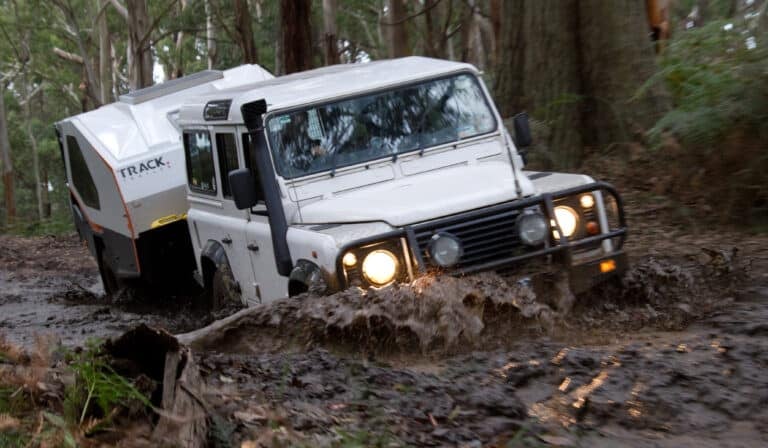

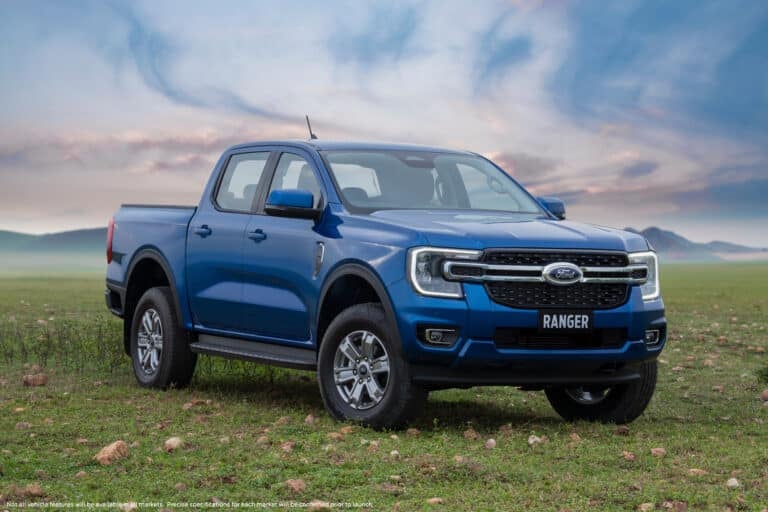
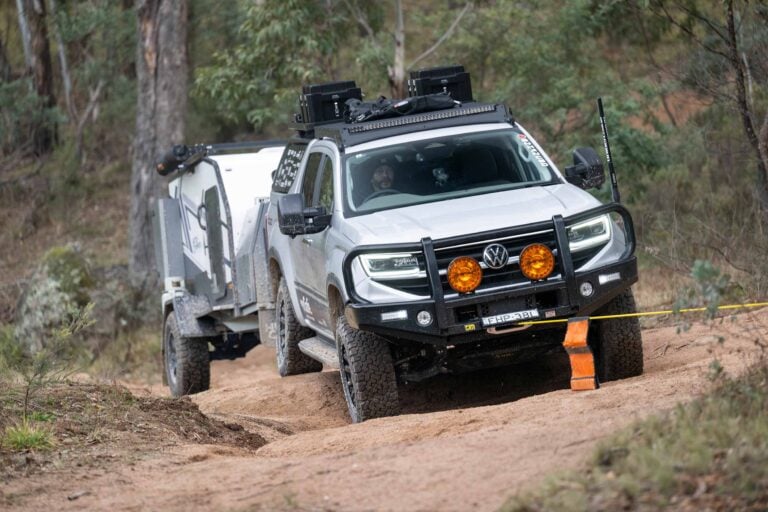
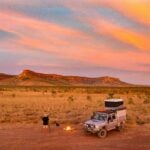


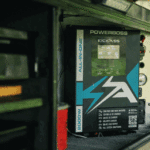
You might like to enlarge what one pedal driving means especially with towing. I assume they have an electronic brake controller installed. Sounds scary if you can’t override/ supplement the engine braking or retarding. Nice vehicle but at that price it will only appeal to those unaffected by inflationary pressures with no financial restrictions and secure employment and no charging time worries in their short travels.